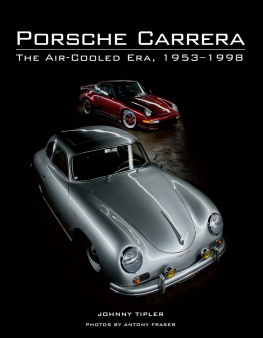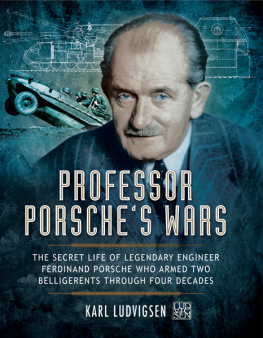PREVIOUS BOOKS BY DENNIS ADLER
The Art of the Sports Car: The Greatest Designs of the 20th Century
The Art of the Automobile: The 100 Greatest Cars
Mercedes-Benz: Silver Star Century
Porsche 911 Road Cars
Chrysler
Fifties Flashback: The American Car
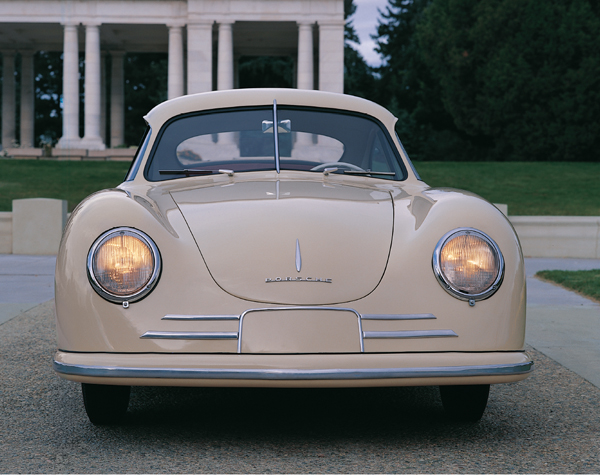
Copyright 2003 by Dennis Adler
Foreword copyright 2003 by Ferdinand Alexander Porsche III
All rights reserved. No part of this book may be reproduced in any manner without the express written consent of the publisher, except in the case of brief excerpts in critical reviews or articles. All inquiries should be addressed to Skyhorse Publishing, 307 West 36th Street, 11th Floor, New York, NY 10018.
Skyhorse Publishing books may be purchased in bulk at special discounts for sales promotion, corporate gifts, fund-raising, or educational purposes. Special editions can also be created to specifications. For details, contact the Special Sales Department, Skyhorse Publishing, 307 West 36th Street, 11th Floor, New York, NY 10018 or .
Skyhorse and Skyhorse Publishing are registered trademarks of Skyhorse Publishing, Inc., a Delaware corporation.
Visit our website at www.skyhorsepublishing.com.
10 9 8 7 6 5 4 3 2 1
Library of Congress Cataloging-in-Publication Data is available on file.
All black-and-white photographs are reprinted courtesy of Porsche Werkfoto.
All color photographs that are uncredited were taken by the author.
Cover design by BTDnyc
Cover photo credit Dennis Adler
Print ISBN: 978-1-62914-678-2
Ebook ISBN: 978-1-63220-092-1
Printed in China
TO JEANNE, FOR HER BOUNDLESS ENCOURAGEMENT AND LOVE,
TO MY FRIEND AND AGENT PETER RIVA, AND
IN MEMORY OF FERDINAND ANTON ERNST FERRY PORSCHE
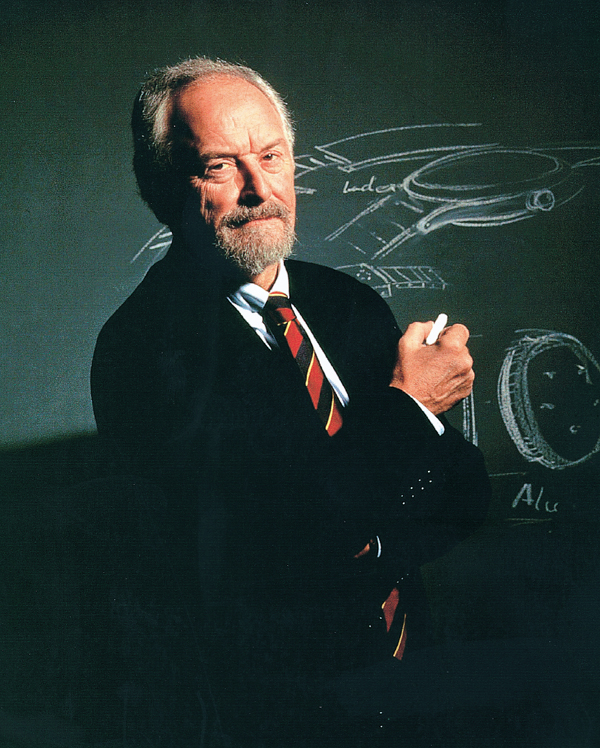
Ferdinand Alexander Butzi Porsche III in his studio at Porsche Design, his own firm, which he formed in Zell am See in 1972. Porsche Design has been responsible for everything from sunglasses to camera designs. Butzi also succeeded his father as chairman of Porsche AGs supervisory board in 1990.
FOREWORD
FERDINAND ALEXANDER PORSCHE III
I N THE BEGINNING I LOOKED AROUND AND, NOT finding the automobile of my dreams, decided to build it myself. This was a statement of my fathers about the creation of our company in a commercial in 1989, and it showed me how much entrepreneurial daring he had at a time when there seemed to be no future. To be dreaming of a sports car, tucked away in a remote Austrian Alpine valley two years after the end of World War II, was nothing less than boundless optimism or evenif one looks at it from todaytemerity. His belief in the future, and his knowledge of the vitality and ability of the designers who attempted with him in Gmnd, Carinthia, to come to grips with postwar conditionsconstructing, for example, winches and direct-flow turbines for agricultureallowed his dream to become reality, to become the Porsche 356.
The dream once realized by my father set the stage for future successes. The company that was started up by my grandfather in 1931 as a limited-liability company, Dr. Ing. h.c. F. Porsche KG, through its experience designing and constructing automobiles, became a manufacturing company, and Porsche was now a manufacturer of its own cars.
My father was twenty-one when he became an assistant to my grandfather in the design office. He was there from the very beginninga crown prince as an eager student among the technical specialists: Karl Rabe, the chief designer; Karl Frhlich, responsible for the transmission; Josef Kales, for the engine; Josef Zahradnik, for the axles; and Erwin Komenda, for the body. I believe that the most important qualities that allowed my father to grow into his future responsibility were his constant willingness to learn, his ability to observe very closely and to listen, as well as his talent for recognizing how situations evolved within the companys administration.
Moreover, in a close family company, conditions were created that nurtured his talents through the clearness of its structure, the logic of its decision-making processes, and the efficiency of its way of doing business. There was, however, also the human component, which was present throughout the company from the very beginning and which also influenced my father. For one thing, there were emotional bonds between the employees themselves: there were also the employees ties to the office, which knew how competent it was and which found itself in an upward trend. Finally, it was the human and professional leadership of my grandfather that united the team and, through his technical visions, kept providing impetus for the future.
The break with the past after World War II was complete, and it fell to my father to develop new strategies for the company. As Albert Prinzing told him on the occasion of his seventy-fifth birthday, my fathers most consequential decision was to develop a small sports car for a new type of customer in a world in which bigger and bigger was thought to be the catchword. Ferry Porsche met that with a small, fast, and decidedly unadorned car with simple, well-proportioned lines. Many Americans lived by the motto to be different; they desired to free themselves from their standardized world, which could be the explanation for Porsches quick success in the largest of markets.
Of course, it was one thing to dream of such a sports car and another to make such a dream come true. However, this is what happened when my father moved the company back to Stuttgart, where he found the necessary conditions to produce cars in the facilities of Reutter and signed a contract with Heinz Nordhoff, the general director of Volkswagen, which provided for VW to supply parts for the sports car and allowed Porsches to be sold and serviced by VW agents and mechanics. In return, Porsche was to give design advice to VW.
This contract provided the material basis for the continuing existence of the company. No less important for the success of the company and for the special success of the Porsche automobile was the devotion the Porsche team had for their cars and the resulting spirit that infused the House of Porsche.
It almost sounds like a manifesto when one reads the forewords to the first issues of the house magazine, Christophorus . They give the priorities of principle that were written down by my father, Carl Otto Windecker, and Richard von Frankenberg. They deal with Automobilism, The Spirit of the House of Porsche, and Porsche Automobile Sport.
What these articles show is a deep emotional relationship to the automobileto the very concept of the automobile in general, and to Porsche in particular. These articles are so typical of the way of thinking of car people shortly after the war and had such an influence on the history of the Porsche company that they are worth quoting today without any further comment on their essential aspects.
Carl Otto Windecker, for instance, describes the phenomenon of Automobilism in this way: The world of the automobile is a force field of nonmeasurable influence upon people who come within its aura. It is a phenomenon which fulfills and captures humans like a new religion.... No other vehicle manufactured by German carmakers has been supplanted or made redundant by the Porschefor it is unique in the broadest sense. The Porsche has become the vehicle of believing fanatics in the new world appreciation of Automobilism.... The sheer beauty of the Porsche releases it from the laws of everyday sober functionalism. Its power and the extraordinary speed it can travel at take it out of normal traffic and contribute to that feeling of liberation which can probably only be surpassed by the experience of flying.
Next page
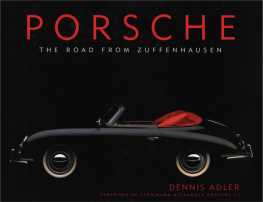


![Trade Trade - Porsche 356 owners workshop manual: [1957-1965]](/uploads/posts/book/237774/thumbs/trade-trade-porsche-356-owners-workshop-manual.jpg)

